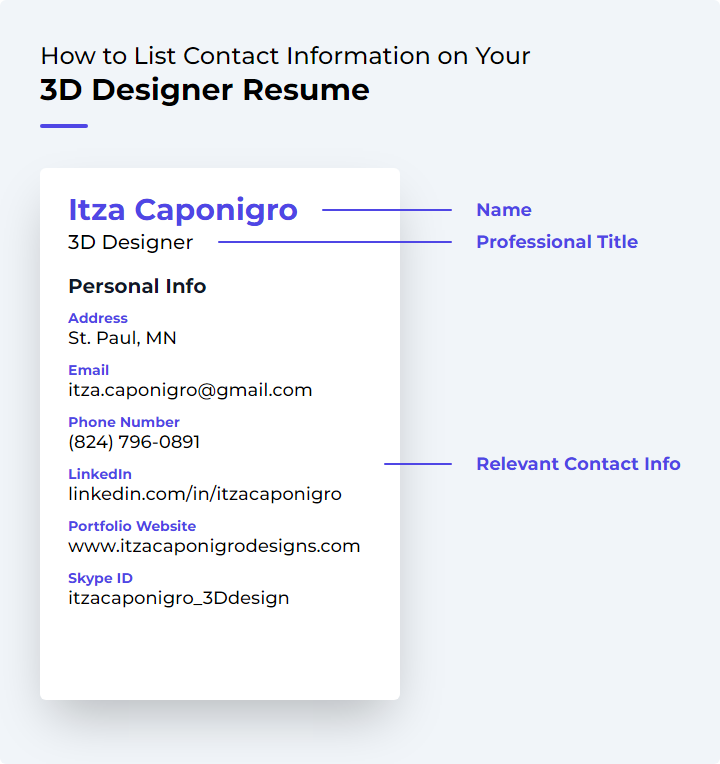3D Designer Resume Examples
Writing a great 3d designer resume is important because it is one of the first things a potential employer will see when they are considering you for a position. It is your opportunity to make a good first impression and sell yourself as the best candidate for the job.
Create your resume
Select from 7 professional resume templates
If you're looking for inspiration when it comes to drafting your own 3d designer resume, look no further than the samples below. These resumes will help you highlight your experience and qualifications in the most effective way possible, giving you the best chance of landing the 3d designer job you're after.
Essential Components of a 3D Designer's Resume
A 3D Designer's resume is a vital tool that showcases their skills, expertise, and unique design capabilities. Crafting a resume that effectively highlights the essential qualities employers seek is crucial. It should include sections such as personal information, employment history, skills, and education, among others.
Each section is critical in demonstrating the candidate's suitability for the role. In this guide, we will delve into each component of a 3D Designer's resume, discussing its importance and content. Additionally, we will provide tips on how to make each section stand out to catch the attention of prospective employers.
1. Contact Information
The first section of your resume should be your contact information. It's essential for employers to have a means to contact you for interviews or further discussions.

Include your full name, home address, phone number, and a professional email address. It's also beneficial to add links to your online portfolio or professional networking profiles like LinkedIn, Behance, or Dribbble, ensuring they are up-to-date and showcase your skills and experience.
- Consider adding your Skype ID or other virtual meeting IDs, as many interviews are conducted remotely.
Ensure all contact information is current and accurate. Be mindful of privacy when posting your resume on public platforms; in such cases, it might be best to provide only your email and phone number.
2. Professional Summary or Objective
A "Professional Summary or Objective" is a must-have on a 3D designer's resume. This section allows you to briefly state your career goals and highlight your most significant 3D design qualifications.
Experienced designers should use the professional summary to showcase their achievements and proficiency in 3D design software. For those new to the field, an objective statement can convey eagerness to apply learned skills in practical settings.
- Professional Summary: For seasoned designers to highlight accomplishments and software expertise.
- Objective Statement: For newcomers to express their readiness to apply their skills in real-world scenarios.
Ensure this section aligns with the job requirements, as it is often the first thing hiring managers read.
Related: Top 3D Designer Resume Objective Examples
3. Skills and Proficiencies
The "Skills and Proficiencies" section is crucial, showcasing the technical and soft skills that qualify you for the job. Tailor this section to each job application, as different employers may prioritize different skills.
- Technical Skills: Proficiency in software like Autodesk Maya, Blender, ZBrush, Cinema4D, SketchUp, AutoCAD, Adobe Creative Suite, Unity3D, Unreal Engine, and programming languages like Python.
- Design Skills: Understanding of design principles, spatial awareness, and the ability to sketch ideas before digital modeling.
- Creativity: The ability to conceive unique concepts and designs.
- Attention to Detail: Precision in crafting complex designs or managing large projects.
- Problem-Solving Skills: Quickly identifying and resolving design or technical issues.
- Time Management & Organization: Managing multiple projects or tight deadlines effectively.
- Communication Skills: Clearly understanding client needs and collaborating with teams.
- Understanding of Production Process: Comprehensive knowledge of the production workflow, including modeling, texturing, lighting, and rendering.
Be honest about your abilities – integrity makes a lasting impression on potential employers.
Related: 3D Designer Skills: Definition and Examples
4. Work Experience in 3D Design
The "3D Design Work Experience" section is pivotal, highlighting your practical experience and expertise in 3D design. Detail your roles, responsibilities, and contributions to projects, starting with your most recent position.
Emphasize the software you used, the complexity of your projects, teamwork, and problem-solving skills. Quantify achievements when possible, and consider including internships or freelance work to bolster your experience.
5. Education and Certifications
The "Education and Certifications" section showcases your academic background and professional qualifications. List relevant degrees, courses, and certifications, starting with the most recent. This information demonstrates your qualifications and commitment to professional development.
Related: 3D Designer Certifications
6. Portfolio of Previous 3D Design Work
Your 3D design portfolio is a tangible demonstration of your skill, creativity, and expertise. Include a variety of work samples, each accompanied by a brief description of the project's goals, tools used, and challenges overcome. An up-to-date online portfolio is highly advantageous.
7. References or Testimonials
References and testimonials provide third-party validation of your skills and work ethic. Include contact details for references and any direct praises or recognitions you've received. This section endorses your professional abilities and adds credibility to your resume.
